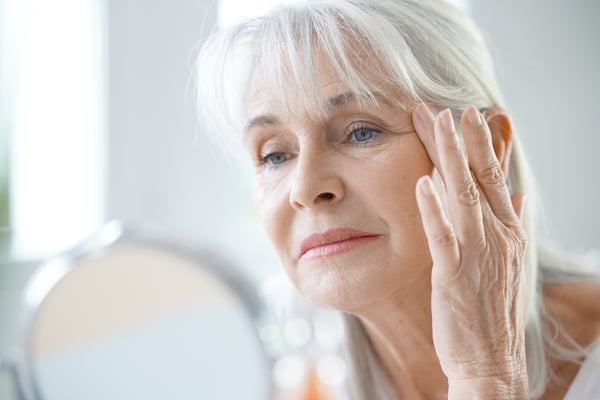Recently, however, initiatives to change the narrative of aging in the beauty industry have shifted how beauty brands market their products to consumers. While many products and companies have stopped using anti-aging as an up front marketing strategy, language used in advertising and marketing still focuses on youth as being a source of beauty. Words like “natural” and “radiant” replace products that used to be advertised as anti-aging, giving consumers the idea that a “youthful glow” is associated with a good skin care and beauty regimen. What it comes down to is that youthful looking skin is, culturally, associated with a good hygiene—suggesting that if a person takes care of themselves, their skin will show for it.
Anti-aging skin care - historically
Historically, women have been told that aging equates to a loss of beauty in the eyes of men. Beauty advertisements throughout the 1900’s have associated signs of aging with a woman’s success in things like finding a husband or getting dates, but such strategies have become obsolete in recent years, particularly now that more women are working in executive roles in business and the roles of gender in the beauty industry have shifted. Women are beginning to embrace aging in new ways, as what was once associated with a loss of beauty is now associated with wisdom.
Aging now represents a time when women are further along in their careers and more established in their sense of self—but that is not to say that anti-aging products are not the most popular products in the beauty market. Despite a change in narrative surrounding signs of aging, consumers are buying just as much—if not more—anti-aging products than ever before. Globally, the anti-aging sector of the beauty market—which includes anything from skin care products to cosmeceuticals and cosmetic procedures like Botox—is expected to hit a valuation of over $270 billion by 2024.
Words like “radiant,” “restorative,” and “repairing” adorn the packaging of products that used to be described as anti-aging. Retinol, a popular ingredient used in anti-aging products for its ability to slough off dead skin cells and increase new skin cell growth, is now marketed as an exfoliant and advertised with words like “smooth” and “glow” to describe its effects on the skin. Meanwhile, products like moisturizers with ceramides and SPF’s are advertised for their preventative aging effects.
Nourishing ingredients for radiant skin

Ceramides, like Phytopresome Cera-V from Nippon Fine Chemical, have the ability to absorb into the skin and add moisture, preventing skin from appearing saggy and wrinkled. Aged skin is often associated with a lack of health, and is advertised as a treatable issue from many beauty companies while embracing aspects of aging that are unavoidable. Age is beauty, according to the beauty industry, but only after the consumer has done his or her due diligence in diminishing the signs of it as much as they can.
Other ingredients that aim to nourish skin as a means of preventing signs of aging are things like hyaluronic acid and collagen increasing ingredients (like Mallow Extract from Koei Kogyo), which both often promise to contribute to a “youthful glow” by improving the natural hydration barrier that maintains healthy skin and helping contribute to a supple, soft appearance, respectively.
The reality is that these same ingredients have been used in anti-aging products for years, but changes in consumer demand have forced beauty manufacturers to think of new ways to advertise the same results. Consumers may not want to be told they need to look younger, but they are still looking to achieve smooth skin that is free of fine lines and wrinkles.
Cosmeceutical procedures and advertising in the modern age
Cosmeceuticals and cosmetic procedures have also had to rethink the ways in which their products are advertised. Botox, a treatment used to diminish signs of aging in the face, has long been associated with a desire to look younger. But the product is being increasingly advertised as a method of reducing signs of constant stress (as stress can contribute to signs of aging).
Cosmetics companies know that consumers that used to be likely to purchase anti-aging products are still looking for similar effects, they just don’t want to be treated like aging is a bad thing. Instead, products are marketed to address external forces that cause wrinkles and fine lines to appear in the first place: smoking, pollution, stress, and other toxins are all found to contribute to signs of aging, for example. Antioxidant ingredients like green tea and charcoal (like DL Activated Charcoal from Devaraux Specialties) are found in masks that promise to draw out impurities and prevent the skin from developing wrinkles. After that, skin care specialists emphasize multi-step routines that involve handfuls of products that each promise to nourish and treat the skin in different ways, preventing aging with each step.
Advertisements for anti-aging products today are about empowering the consumer and making them feel more confident, even if that means accepting that their skin has some level of age to it. Many products that are marketed as having natural ingredients emphasize health as beauty. Healthy skin, for this reason, is often attributed to youth. Even among aged skin types, products are marketed toward older people with words using “radiant” or “glow” to help these consumers feel confident and youthful.
Disclaimer: The information provided (on our blog) is accurate to the best of our knowledge, however, there may be errors. As a neutral organization, we at Covalo do not advocate or promote certain products or ingredients on our platform as better than others. The Site may contain (or you may be sent through the Site) links to other websites or content belonging to or originating from third parties or links to websites and features in banners or other advertising. Such external links are not investigated, monitored, or checked for accuracy, adequacy, validity, reliability, availability or completeness by us. For more information on our blog, contact social@covalo.com


